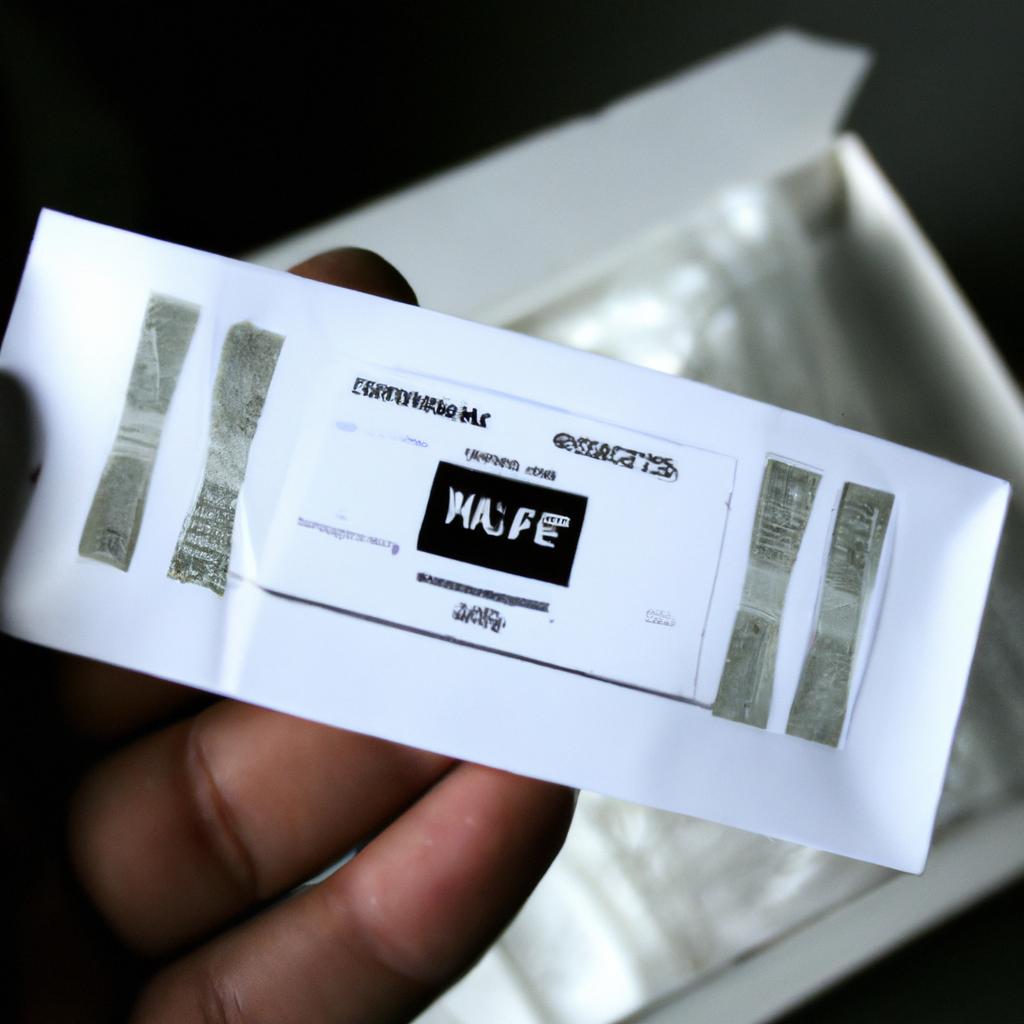DNA testing has revolutionized the field of genealogy, providing individuals with a powerful tool to uncover their ancestral roots and connect with distant relatives. With advancements in technology, DNA testing has become more accessible and affordable, attracting an increasing number of people seeking to explore their family history. This article aims to delve into the world of DNA testing in genealogy and highlight its significance as an ancestry assistance education tool.
One compelling example that illustrates the impact of DNA testing on genealogical research is the case study of Jane Smith, who embarked on a journey to discover her origins through genetic analysis. By submitting a simple saliva sample for testing, she was able to obtain valuable insights about her heritage that were previously unknown to her. Through this process, Jane discovered unexpected connections with distant relatives across continents and pieced together missing branches in her family tree. Such success stories demonstrate how DNA testing can provide vital clues and bridge gaps in one’s understanding of their ancestral lineage.
In recent years, there has been significant growth in both the popularity and availability of consumer DNA tests offered by various companies specializing in genetic genealogy. These tests analyze specific segments of an individual’s DNA sequence known as autosomal markers or single nucleotide polymorphisms (SNPs) to determine ethnic composition and to identify potential matches with other individuals in their DNA database. This approach allows individuals to not only gain insights into their ethnic origins but also connect with relatives they may have never known existed.
The process of DNA testing for genealogy typically involves collecting a sample, usually through saliva or cheek swabs, and sending it to the testing company. The company then analyzes the DNA sample and provides a detailed report that outlines the individual’s genetic ethnicity estimate, which indicates the percentage breakdown of different ancestral populations in their DNA. Additionally, the report often includes a list of potential relatives who have also taken the same test, ranked by genetic similarity.
By comparing shared segments of DNA between two individuals, genetic genealogists can determine how closely related they are and infer common ancestors. This information can be used to build family trees, trace lineage back several generations, and even discover previously unknown branches of one’s family tree.
DNA testing has proven particularly useful for adoptees or individuals with limited knowledge about their biological families. It can help them find biological relatives and potentially reunite with long-lost siblings or parents. In some cases, DNA testing has led to emotional reunions and provided closure for those seeking answers about their identity and heritage.
Furthermore, DNA testing in genealogy is not limited to autosomal markers alone. Other types of tests include mitochondrial DNA (mtDNA) testing, which traces maternal ancestry along the direct maternal line, and Y-chromosome DNA (Y-DNA) testing, which traces paternal ancestry along the direct paternal line. These tests can provide further insights into specific ancestral lines and help uncover deeper connections within one’s family history.
It is essential to note that while DNA testing is a powerful tool for genealogical research, it should be used in conjunction with traditional genealogical methods such as records searches, interviews with living relatives, and historical documents. Combining these approaches can yield more comprehensive results and ensure accuracy in tracing one’s genealogy.
In conclusion, DNA testing has revolutionized the field of genealogy by providing individuals with valuable insights into their ancestral roots and connecting them with distant relatives. It has become increasingly accessible and affordable, making it a popular tool for those seeking to explore their family history. The success stories of individuals like Jane Smith demonstrate how DNA testing can bridge gaps in understanding one’s ancestry and provide vital clues that were previously unknown. As technology continues to advance, DNA testing will likely play an even more significant role in unraveling the mysteries of our past.
The Importance of DNA Testing in Genealogy
The Importance of DNA Testing in Genealogy
DNA testing has emerged as a powerful tool in genealogy, enabling individuals to uncover their ancestral origins with greater accuracy and depth. By analyzing an individual’s genetic makeup, DNA tests can provide valuable insights into one’s heritage, helping to trace family lineages back several generations. For instance, consider the case of Sarah Johnson, who had always been curious about her ancestry but lacked sufficient documented evidence. After taking a DNA test, she discovered that her roots could be traced back to Ireland and Scotland, providing her with a sense of connection to her ancestors.
Understanding the significance of DNA testing in genealogy requires recognizing its ability to reveal hidden information that may not be apparent through traditional research methods alone. This newfound knowledge enables individuals like Sarah Johnson to gain a better understanding of their cultural identity and historical background. Moreover, it allows them to connect with distant relatives and build meaningful relationships based on shared genetic connections.
To highlight the emotional impact of DNA testing in genealogy, here are some key points:
- Sense of Belonging: Uncovering ancestral origins offers a profound sense of belonging for individuals seeking answers about their heritage.
- Identity Formation: Knowledge gained from DNA testing aids in shaping personal identities by providing insight into familial traditions and customs.
- Family Reunions: Discovering long-lost relatives often leads to joyous reunions, forging new bonds among previously unknown family members.
- Cultural Exploration: Delving into one’s ancestry opens doors for exploring different cultures and embracing diverse perspectives.
This table showcases how DNA testing enhances the emotional aspect of genealogical research:
| Emotional Benefit | Example |
|---|---|
| Sense of Belonging | Finding out you have Native American heritage |
| Identity Formation | Discovering your great-grandmother was an accomplished artist |
| Family Reunions | Meeting cousins from across the world for the first time |
| Cultural Exploration | Learning about unique traditions and customs from your ancestors |
By harnessing DNA testing in genealogy, individuals can gain a deeper understanding of their roots and establish meaningful connections with their past. In the subsequent section, we will explore different types of DNA tests to unravel specific aspects of one’s ancestry without skipping a beat.
Understanding Different Types of DNA Tests
In the previous section, we discussed the importance of DNA testing in genealogy. Now, let’s delve deeper into understanding different types of DNA tests that are commonly used in ancestry research.
To illustrate the significance of these tests, consider a hypothetical scenario where an individual named Sarah wants to trace her paternal lineage. She decides to take a Y-DNA test, which specifically examines the male line through the father and his father’s father. This test can provide valuable insights into surname origins, migration patterns, and potential matches with other individuals who share similar markers on their Y chromosome.
When it comes to DNA testing for genealogy purposes, there are several options available. These include:
- Autosomal DNA Test: This type of test analyzes segments of your autosomes (non-sex chromosomes) inherited from both parents. It provides information about your ethnicity estimates and helps identify relatives across all ancestral lines within approximately five to six generations.
- Mitochondrial DNA Test: Focusing on the maternal line exclusively, this test examines mitochondrial DNA passed down from mothers to their children. It allows individuals to explore deep ancestral roots and detect possible connections with others who share a common maternal ancestor.
- X-Chromosome Test: The X-chromosome test is particularly useful in identifying relationships along specific branches of one’s family tree. It enables researchers to determine if certain traits or genetic variations have been inherited from particular ancestors.
To give you a visual representation, here is a table summarizing the main features of each type of DNA test:
| Type of Test | Focus | Ancestral Line |
|---|---|---|
| Autosomal | All ancestral lines | 5-6 generations |
| Mitochondrial | Maternal line | Deep ancestral roots |
| Y-Chromosome (Y-DNA) | Paternal line | Male-line heritage |
| X-Chromosome | Specific branches | Inheritance patterns |
Understanding the different types of DNA tests available for ancestry research allows individuals like Sarah to make informed decisions about which test(s) will best suit their genealogical goals.
Transitioning seamlessly into the subsequent section on “Choosing the Right DNA Testing Company,” it is essential to consider various factors before selecting a specific provider.
Choosing the Right DNA Testing Company
Now that we have gained insight into the importance of DNA testing in genealogy, let us explore the different types of DNA tests available. To illustrate this further, consider a hypothetical case study where an individual named Sarah wants to uncover her ancestral roots. Sarah decides to embark on a journey of genetic discovery and opts for three different types of DNA tests: autosomal DNA test, mitochondrial DNA (mtDNA) test, and Y-chromosome DNA (Y-DNA) test.
The first type of DNA test is the autosomal DNA test, which examines chromosomes inherited from both parents. This test provides information about recent ancestry within approximately five generations. It can provide valuable insights into one’s ethnic makeup and connect individuals with potential relatives who share common ancestors. For instance, Sarah discovers through the autosomal DNA test that she has 25% European ancestry, suggesting that some of her distant relatives likely originated from Europe.
In addition to the autosomal DNA test, Sarah also undergoes a mtDNA test. Mitochondrial DNA is inherited maternally and remains relatively unchanged over many generations. This makes it particularly useful for tracing maternal lineages back hundreds or even thousands of years. Through this test, Sarah learns about her direct maternal lineage, gaining a deeper understanding of her family history on her mother’s side.
Lastly, Sarah chooses to take a Y-DNA test as part of her genetic exploration. Unlike mtDNA, Y-DNA is passed down exclusively from father to son and allows individuals to trace their direct paternal lines. By analyzing specific markers on the Y chromosome, this test helps identify male relatives who share a common ancestor with Sarah along her patrilineal line.
- Discovering unknown connections with long-lost relatives.
- Unveiling hidden ancestral roots and ethnic backgrounds.
- Understanding migration patterns and the historical context of one’s ancestors.
- Establishing a sense of belonging and identity through knowledge of one’s genetic heritage.
To further engage the audience, let us present a table that compares the different types of DNA tests:
| Type of DNA Test | Inheritance Pattern | Ancestral Timeframe |
|---|---|---|
| Autosomal DNA Test | Inherited from both parents | Around five generations |
| mtDNA Test | Maternal inheritance | Hundreds to thousands of years |
| Y-DNA Test | Paternal inheritance | Thousands of years |
By examining this table, individuals like Sarah can gain an understanding of which test(s) would be most suitable for their genealogical goals. Whether they seek recent connections or aim to delve deeper into ancient lineages, each type offers unique insights into their family history.
Transitioning smoothly into the subsequent section on interpreting DNA test results, it is crucial for individuals to understand how to make sense of the wealth of information provided by these tests. By learning how to interpret their DNA test results accurately, individuals can unlock a treasure trove of knowledge about their ancestry and create meaningful connections with relatives across time and distance.
Interpreting DNA Test Results
DNA Testing in Genealogy: Ancestry Assistance Education
Choosing the Right DNA Testing Company can be overwhelming, given the numerous options available in the market today. To make an informed decision, it is crucial to consider various factors such as testing methods offered, database size, and privacy policies. Let us explore a hypothetical example to illustrate the importance of selecting the right company.
Consider Sarah, who is interested in tracing her paternal lineage. She decides to take a DNA test with Company A because they offer comprehensive Y-DNA testing specifically for male ancestry research. Unfortunately, after receiving her results, she realizes that Company A has a relatively small database compared to other companies. As a result, Sarah’s chances of finding matches and uncovering more about her paternal roots are significantly limited.
To help you navigate through this process effectively, here are some key points to consider when choosing a DNA testing company:
- Database Size: The larger the database, the greater your chances of finding genetic relatives and expanding your family tree.
- Testing Methods Offered: Different types of tests provide varying degrees of information regarding different ancestral lines (such as Y-DNA for direct paternal line or mtDNA for direct maternal line), so choose according to your specific goals.
- Privacy Policies: Ensure that the company respects your privacy by carefully reviewing their data storage practices and sharing policies.
- Additional Features: Some companies offer additional tools like ethnicity estimates or access to genealogical databases; these features may enhance your overall experience.
In summary, choosing a reputable DNA testing company with a large database and appropriate testing methods tailored to your research objectives will greatly impact the success of your genealogical journey.
Interpreting DNA Test Results paves the way for understanding how to extract valuable insights from your genetic information. By analyzing markers on specific chromosomes or using complex algorithms based on population genetics studies, testing companies generate reports that provide detailed information about ethnic origins and potential genetic matches within their databases.
Combining DNA Testing with Traditional Genealogical Research allows for a holistic approach to building your family tree. By integrating the information obtained from DNA testing with traditional genealogical records, such as birth certificates, census data, and historical archives, you can validate and expand upon the connections suggested by genetic matches. This comprehensive method enables a more accurate representation of your ancestry, filling in gaps that may have been left unaddressed solely through traditional research methods.
Continuing our exploration into the integration of DNA testing and traditional genealogical research, we will delve deeper into strategies for maximizing this combined approach.
Combining DNA Testing with Traditional Genealogical Research
Continuing the Journey: Combining DNA Testing with Traditional Genealogical Research
Now, let’s delve into the exciting world of combining DNA testing with traditional genealogical research methods. To illustrate this synergy, let’s consider a hypothetical scenario involving Sarah, who is trying to uncover her paternal lineage.
Sarah has already taken a DNA test and received her results. The genetic matches indicate potential relatives on her father’s side. However, she lacks concrete information about her paternal grandfather due to limited family records. In order to bridge this gap, Sarah decides to integrate her DNA findings with traditional genealogical research techniques.
Here are some ways in which Sarah can combine DNA testing and traditional research:
- Identifying common ancestors: By comparing shared segments of DNA with known relatives, Sarah can identify common ancestors and potentially uncover previously unknown branches of her family tree.
- Validating existing research: If Sarah has conducted prior genealogical research but wants additional evidence or confirmation, analyzing her DNA alongside those findings can provide valuable validation.
- Overcoming brick walls: Sometimes traditional research hits roadblocks due to incomplete records or missing links. Here, DNA testing can help break through these barriers by identifying connections that were previously elusive.
- Discovering hidden heritage: Through ethnicity estimates provided by some DNA testing companies, individuals like Sarah might gain insights into their ancestral origins beyond what was documented in historical records alone.
To further illustrate the power of combining these approaches, let us present a table showcasing an example case study:
| Ancestor | Traditional Research Findings | DNA Test Results | Combined Findings |
|---|---|---|---|
| John Smith (paternal grandfather) | Limited records; no direct evidence linking him to Sarah | Genetic match indicating possible connection on paternal line | Shared segment analysis identifies common ancestors on paternal line, confirming John Smith’s connection to Sarah |
As we can see from this table, the combination of DNA testing and traditional genealogical research allows for a more comprehensive understanding of Sarah’s ancestry. By leveraging both approaches, she was able to confirm her link to John Smith, her previously mysterious paternal grandfather.
In conclusion, integrating DNA testing with traditional genealogical research can enhance our ability to unravel complex family connections and uncover hidden branches of our lineage. In the subsequent section on ethical considerations in DNA testing for genealogy, we will explore important factors that one should keep in mind when embarking on this journey of discovery.
Ethical Considerations in DNA Testing for Genealogy
Combining DNA Testing with Traditional Genealogical Research
Building upon the foundation of traditional genealogical research, DNA testing has become an invaluable tool in uncovering ancestral connections and deepening our understanding of family history. By analyzing genetic markers within our DNA, we can reveal hidden branches on the family tree and gain insights into our heritage that may have otherwise gone unnoticed.
For instance, let’s consider a hypothetical case study involving Sarah, who is researching her paternal lineage. Through traditional methods such as census records and vital documents, she was able to trace her ancestry back several generations. However, there were still gaps in her knowledge due to limited available documentation during certain time periods. By opting for a DNA test, Sarah discovered distant relatives who possessed extensive family histories and photographs that filled those missing pieces. This integration of DNA testing with traditional research allowed her to paint a more comprehensive picture of her ancestors’ lives.
To maximize the benefits of combining DNA testing with traditional genealogical research, it is essential to approach the process systematically and thoughtfully. Here are some key considerations:
- Selecting the right type of DNA test: Different types of tests offer varying levels of specificity and depth when it comes to tracing different aspects of one’s ancestry.
- Analyzing shared matches: Exploring shared matches among individuals identified through DNA testing can provide valuable clues about common ancestors or previously unknown branches.
- Triangulating data: Comparing results from multiple family members can help identify specific segments of shared DNA that depict common ancestors.
- Researching haplogroups: Investigating haplogroups associated with maternal or paternal lineages offers fascinating insights into ancient migration patterns and geographic origins.
To illustrate these considerations further, here is a table showcasing the potential emotional impact when combining DNA testing with traditional genealogical research:
| Consideration | Emotional Impact |
|---|---|
| Selecting the right test | Excitement and anticipation of uncovering heritage |
| Analyzing shared matches | Thrill of discovering previously unknown relatives |
| Triangulating data | Sense of accomplishment in solving genealogical puzzles |
| Researching haplogroups | Fascination with ancient origins and migrations |
In summary, integrating DNA testing into traditional genealogical research offers a powerful approach to unraveling family history. By carefully selecting the right test, analyzing shared matches, triangulating data, and researching haplogroups, individuals can enhance their understanding of their ancestry while experiencing a range of emotional impacts along the way. This integrated methodology allows us to bridge gaps in our knowledge and create a more complete narrative of our familial pasts.




